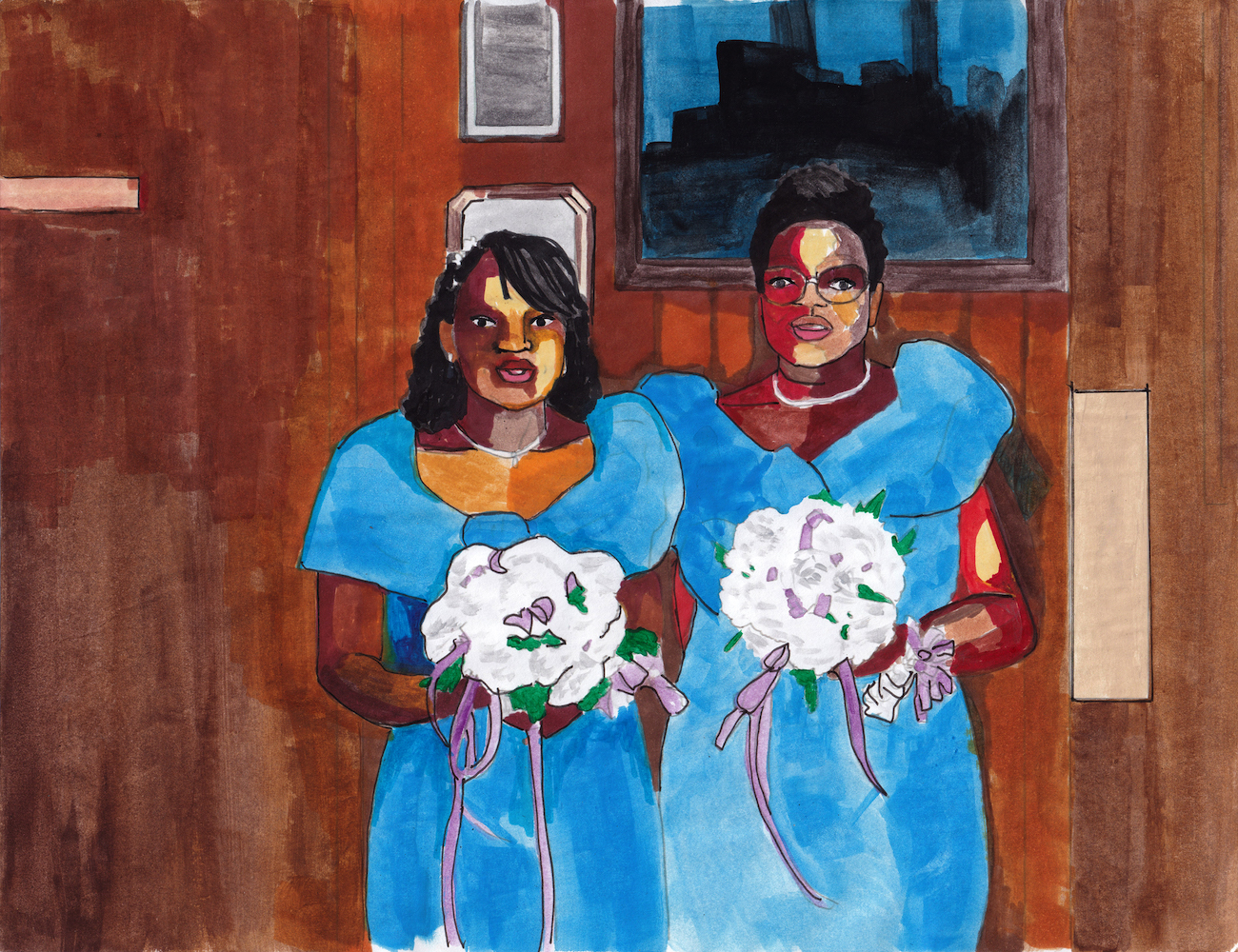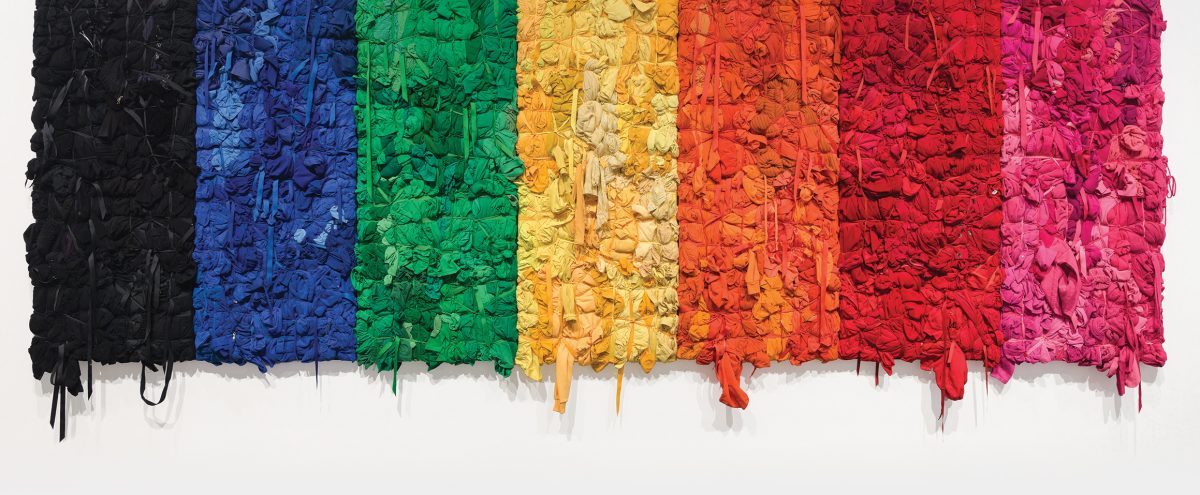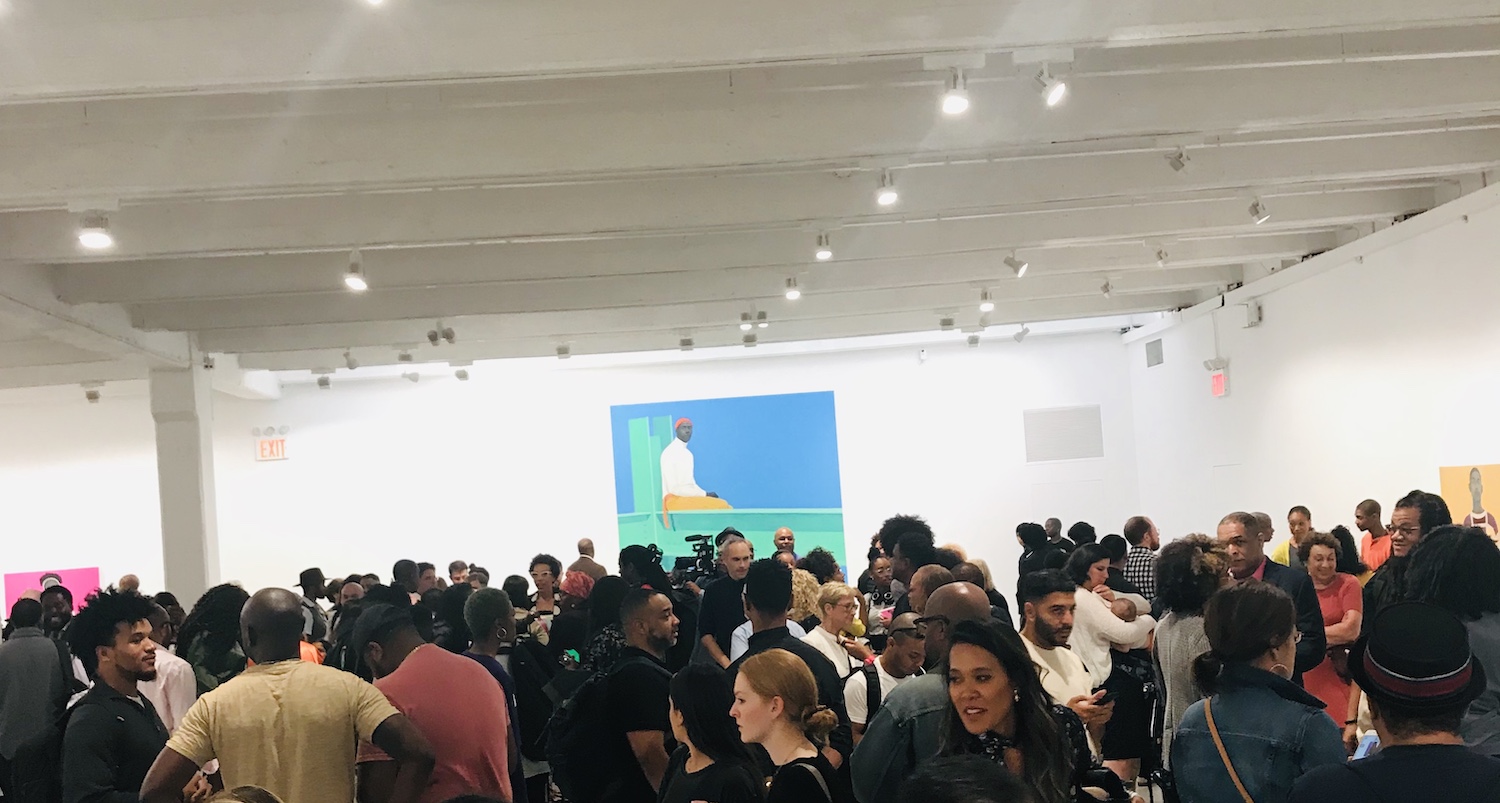I should have arrived earlier. The line stretched down the block to enter Hauser & Wirth, host to Amy Sherald’s first New York solo show, The Heart of the Matter…, a testament to an artist’s popularity so great it appeared to eclipse the art world itself. It was incredible: the department store-sized mega-gallery on 22nd Street in Chelsea, large enough to hold hundreds (thousands?) of bodies, clearly an insufficient vessel for opening night. The energy was buzzing and palpable, where ordinary art fans from across the country and friends of the artist mixed with celebrities, both the art world and People magazine kind, and cameras flashed and champagne flutes clinked, and everyone, absolutely everyone, was happy to celebrate an artist whose success is well deserved and hard earned.
I attended Sherald’s press preview the day before, so instead of waiting in line I snuck in the back door through the bookshop and through Ed Clark’s gorgeous exhibit of abstract paintings on the ground floor. Once inside, I was shocked to discover a second line snaking through the first floor gallery right through Clark’s show, with confused-looking patrons waiting to climb the narrow staircase to the second floor, and a gallery attendant stationed at the foot of the stairs directing traffic and only allowing people up when others exited. Note to Hauser & Wirth: next time put Amy Sherald’s show on the ground floor. It was no fault of his own, but I felt bad for Clark, whose show was treated by some attendees as a waiting room for the main attraction, with people frantically texting their friends upstairs instead of taking in his masterful work. The crowd was huge, but context is everything.
Once upstairs, Kimberly Drew and Jordan Casteel and Padma Lakshmi and Anderson Cooper mingled with art fans from New York as well as a large contingent from Baltimore. Not bad for a Tuesday night! Sherald, gorgeous in an original Christian Siriano pantsuit in black and white stripes with polka dot jacket, was sublime, smiling for cameras and trailed by video cameras for much of the evening. People lined up to get their picture taken with her, and she was a gracious celebrity, smiling and joking with them amiably, hiding all traces of the introverted artist her Baltimore friends know her to be.
The previous day, the cavernous gallery was filled with about 250 chairs for the press preview, where publicists, writers, and editors learned more about Sherald’s ideas and inspiration through a talk with Hammer Museum curator Erin Christovale. It was short, maybe 20 minutes long, and I was familiar with all of its talking points, having seen the two in discussion at the National Gallery of Art in DC a year or so before, but it was interesting to see how Sherald’s concepts have evolved, more about the history of photography now in contrast to the magical realism which influenced earlier works.
 Hauser & Wirth introduces Erin Christovale and Amy Sherald in front of “Precious jewels by the sea” (2019) at the press preview
Hauser & Wirth introduces Erin Christovale and Amy Sherald in front of “Precious jewels by the sea” (2019) at the press preview
When the time for a Q&A arrived, I asked about Baltimore’s influence and generosity towards her career, and Sherald said warm, glowing things about her love for the city that molded her into the artist that she is. I had taken issue with an earlier story in Vogue by Dodie Kazanjian that summed up Sherald’s Baltimore experience as squalorific suffering: “She waitressed five nights a week to pay for her $300-a-month studio in a boarded-up old car garage that had no air-conditioning or heat. She would paint in her underwear in the summer and freeze in the winter, working until her fingers got numb.”
It seemed like a cliché for a certain brand of brokenness Baltimore is known for, a narrative that I work against every day. I’m not saying the statement in Vogue was untrue, just that Sherald’s Baltimore story goes deeper, is much more layered and less of a stereotype. In a similar context, it would be powerful to challenge those stereotypes by talking about her studio at the Creative Alliance, the state-of-the-art facility and residency where she lived and worked for three years and exhibited her work alongside Ebony Patterson, or the light-filled, newly renovated studio at Motor House where she painted Michelle Obama’s portrait, or the SubBasement Artist Studios where she made her first sales and commissions.
An artist’s career evolves and biography must mature in step with one’s career. To tell a good story or make a successful painting, editing is paramount, but I do hope that in the future Sherald’s Baltimore story can be told more completely by those who write about her. People love a dramatic rags-to-riches tale where an artist’s suffering is fetishized and success is a matter of fate, rather than a slow slug of hard work and struggle and friendship and collaboration. Sherald survived a heart transplant and lost her brother, experienced great suffering and tragedy, much of it while in Baltimore, but still managed to focus around a singular idea that has been uniquely hers for the past fifteen years. It’s satisfying to see that has paid off, and so spectacularly. You see this determination in the paintings.
 Top L-R: “A single man in possession of a good fortune” (2019); “The girl next door” (2019); “When I let go of what I am, I become what I might be (Self-imagined atlas)” (2018); and “There is no charm equal to tenderness of heart” (2019)
Top L-R: “A single man in possession of a good fortune” (2019); “The girl next door” (2019); “When I let go of what I am, I become what I might be (Self-imagined atlas)” (2018); and “There is no charm equal to tenderness of heart” (2019)
Sherald’s selection as portrait painter for Michelle Obama was a poorly kept secret in Baltimore, and those of us who showed, purchased, wrote about her work, or visited her studio on the regular always knew that she was on a trajectory for a much larger success. She is now a full-fledged superstar, featured in clothing ads in magazines and in TV shows, and the turnout at her NY opening was a testament to this status. Hauser & Wirth, ostensibly the world’s largest and most powerful gallery, appeared to be struggling to keep up with her, seemingly surprised and a little unprepared for the phenomenal turnout for the exhibit’s opening. It’s especially exciting to watch the way Sherald’s success and fame has unfolded and continues to challenge the long-held traditions and boundaries of the art world, proving some of them to be a sham, and acting as a trailblazer in multidimensional ways for other artists.
With all that she is constantly doing in the public eye and knowing how methodically she paints, I was most curious to look for the impact of success upon her work. Not all artists rise to the occasion of seemingly overnight fame, and many are paralyzed by it. Sherald’s opening was way too crowded to even see the paintings, but in a quiet space before the press preview, I spent time with each portrait, some more than others. Like brightly colored jewels, each radiated a uniquely Amy Sherald energy well beyond their modest size where dignity, style, confidence, and a certain matter-of-fact-ness comes together into a product simultaneously regal and girl-next-door. Sherald has always said that her painting cannot be rushed, and meeting deadlines is incredibly stressful, but the resulting scarcity continues to enhance the quality of each new work, rather than weaken it. With just eight works in the show, all but one created in the past year, the contrast between Hauser’s giant white walls and the mostly modest-sized paintings was shockingly profound. Hung low, purposefully at eye level, the works were energized by the overwhelming space around them, and the awareness of sky-rocketing Chelsea real estate prices reinforced the value of each work.
The artist’s refusal to be rushed or compromise her working process to accommodate the perception of success or a mega-gallery or worldwide fame and/or skyrocketing sales prices is also a powerful statement. Of the eight paintings there were two larger works and one, in particular, “If You Surrendered to the Air, You Could Ride It,” (2019)—featuring a smartly dressed man sitting on metal construction beams in front of an empty background, reminiscent of the iconic “Men at Lunch” 1932 photographs of steel workers on metal girders hundreds of stories up—was the standout piece. Perhaps it was the singing contrast of the color, the man’s languid, model-like pose, the intricate pants stripes painted with a decadent feather-light hand, or the cast shadow of his belt which created a tiny yet extraordinary moment of intimate space, but this was the painting that dominated the show and is undoubtedly the one you have seen most on social media.
Sherald has said for years that she painted figures as life-size, but cut the feet off because of the limitations of her studio and budget. Now that she has a huge studio and resources, it’s exciting to see the artist flex her muscles compositionally and conceptually to include the built environment and theatrical suggestions of physical context. It would have been safe to continue at the same size and with the same color-filled flat backgrounds of the past, but with the addition of size and scale, Sherald has stepped up to a new challenge and, very publicly, shown that she is ready to continue to grow as an artist, a heroic act given the global stage.
 “If You Surrendered to the Air, You Could Ride It,” 2019
“If You Surrendered to the Air, You Could Ride It,” 2019
After witnessing Sherald evolve as an artist and writing about her work over the past decade, I am most fascinated by the way these paintings function, successful beyond prediction, in their new context. Sherald’s figures are lovable, familiar friends, solidly conceived over many years of practice; they have now reached a pinnacle of audience and recognition that few artists ever reach. Her work is the right work for this time and place, and her description of the figures as Americans presents fundamental opportunities for viewers to engage with the larger social, political, and economic issues of our time through images that harness a timeless beauty.
This week, two of the world’s top art critics weighed in on the show and their reviews are sanguine and giddy. In the New York Times, Roberta Smith described the exhibit as “startlingly spare, in an enormous space,” and the paintings as “smoldering yet self-contained.” Smith discussed the impact of Sherald’s signature style, where grisaille, the neutral grayish skin tones, gives them a sense of timelessness. “It conjures the early photography by which black people, having been largely excluded from painting, joined American visual culture,” she wrote.
In the New Yorker, in an essay titled “The Amy Sherald Effect,” Peter Schjeldahl wrote that “Race anchors Sherald’s project in history.” Comparing her use of grisaille to Kerry James Marshall’s rendering of his subjects as coal black, he states that both artists “apostrophize America’s original sin and permanent crisis: the otherizing of the not white, regardless of gradations… To explain the startling authority of Sherald’s art, you must think back to periods when portraiture was a vital function of painting and then, returning forward, incorporate as mainstream the apposite contributions of honored but too often patronized black American artists such as Romare Bearden, Jacob Lawrence, and Charles White.” Comparing Sherald to the titans of figurative Black artists is apt, but I would also argue that this racial division among artists continues to “otherize” artists of color and I am curious to read reviews by critics of color for more context.
The Heart of the Matter… is a standout, significant show that will entice visitors from across the world and this, in itself, is a dizzying achievement worth consideration, study, and tribute. Like Schjeldahl, I believe that Sherald’s work is changing the way we view ourselves in the present reality, and will have an impact upon the way we view our past, too. “I had a dizzy sensation at the Sherald show—which was so much better than I had expected—of ground shifting under my feet,” he wrote, and I agree completely.
Context, time, place, and fame imbues art with the power to spur our thinking and influence our view of reality, to actually change hearts and minds. As individuals, humans, artists, a city, and a country, we have plenty to learn from Amy Sherald’s paintings and her career. Like the Americans she paints, Sherald now has the power to shape a new national narrative, and it will be fascinating to continue to observe this evolution, even if from a distance.
 Credit: Amy Sherald and Hauser & Wirth; Joseph Hyde
Credit: Amy Sherald and Hauser & Wirth; Joseph Hyde
Top Image: Crowds on opening night at The Heart of the Matter… at Hauser & Wirth by the author






